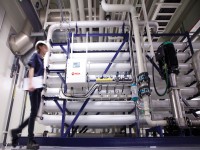Utilising RO water
Published: 14 October, 2014
There have been many new technologies developed over the last half century to eliminate the need for open evaporative cooling but none of them have the efficiency that straight water-cooling can deliver. Andy Perkins sales manager, Kirton Engineering, reports.
There are the well-known down sides to using water cooling, not least is the need to be totally compliant to L8 and the upcoming HSG 274 plus any other relevant codes of practice.
Apart from the cost of scale and corrosion inhibitors and suitable biocidal control is the cost of water. Most cooling towers are controlled by bleeding off a certain proportion of water to ensure that there is no build-up of contaminants that cause a build-up of deposits or lead to corrosion of wetted areas.
pH control is necessary in cooling towers where a protective epoxy coating is present as too high a pH can lead to degradation of the coating and if the base metal is galvanised this can start to deteriorate.
Chlorides
Chlorides are also a particular area of concern in certain cooling towers as chloride attack of welds can take place in lower grade stainless steel fabricated systems. Very often total concentration factors and bleed rates are governed by this factor alone.
Using Reverse Osmosis (RO) water as part of the cooling tower make up water the total level of chlorides can be reduced to an acceptable level as well as reducing the pH of the overall make up water.
In order to for this to be cost effective the cost of producing the RO water (water, reject, salt and power) has to be low enough to allow the total cost benefit to be realised.
Very often factories have a total effluent discharge cap and as such any reduction in cooling tower bleed rates is very welcome and sometimes necessary.
By running an RO plant with a softened make up feed at 90% recovery rather than the traditional 75-80% it is possible to achieve water savings as well as increasing the total cycles of concentration in the cooling system and thus reducing the total volume of chemicals required.
Such systems are in operation based on a ratio of 50% RO water, 45% soft and 5% hard water.
For further information please visit: www.kirton.co.uk





 With ever increasing sustainability, regulatory and financial pressures, VEOLIA WATER TECHNOLOGIES says now is the time to Rethink Water with its help. The company says Circular Economy initiatives operated by WRAP (Waste and Resources Action Programme) have achieved water reductions in many industries so what more can be done in 2017? Veolia says rethinking water can open up a wide range of opportunities to manage water more efficiently, reduce consumption and save money via water reuse or reduced discharge costs.
With ever increasing sustainability, regulatory and financial pressures, VEOLIA WATER TECHNOLOGIES says now is the time to Rethink Water with its help. The company says Circular Economy initiatives operated by WRAP (Waste and Resources Action Programme) have achieved water reductions in many industries so what more can be done in 2017? Veolia says rethinking water can open up a wide range of opportunities to manage water more efficiently, reduce consumption and save money via water reuse or reduced discharge costs.
